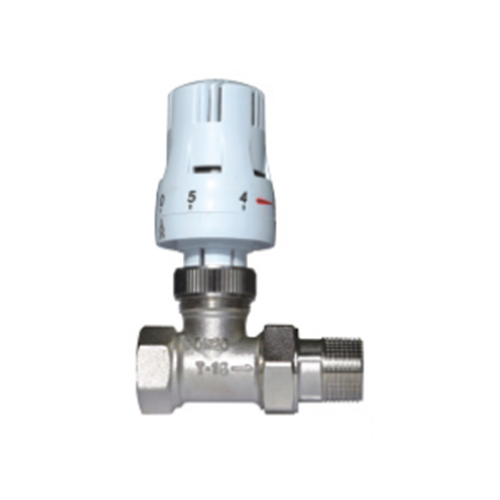TECHNIAL STANDARD
1.Nominal Pressure:PN≤1.6MPa
2.Working Medium:Water,oil,non-comosive and non-combustible gas
3.Working Temperature:-20℃≤T≤110℃
4.Pipe thread to ISO 7
DN | SIZE | L | B | H | D |
15 | 1/2 | 74.4 | 11 | 59.8 | 36 |
20 | 3/4 | 87.4 | 15.5 | 62 | 43 |
25 | 1 | 77 | 18 | 95 | 46.5 |
straight radiator valve: Performance, Upgrade Solutions, Usage Precautions, and Maintenance Frequency
The straight radiator valve is an essential component in modern heating systems, designed to regulate the flow of hot water or steam into radiators. With its straight-through design, the valve ensures efficient heat distribution, precise temperature control, and reliable operation. Constructed from durable materials such as brass or stainless steel, straight radiator valves provide long-lasting performance and corrosion resistance, making them ideal for residential, commercial, and industrial heating systems.
This article provides a detailed overview of product performance, upgrade options, usage precautions, and recommended maintenance frequency, giving homeowners, engineers, and HVAC professionals a comprehensive understanding of straight radiator valves.
A straight radiator valve is a mechanical control device that regulates the flow of heating medium directly into a radiator. Unlike angled valves, its straight configuration allows direct inline installation, which simplifies piping and reduces pressure drop.
Key Features:
Straight-through design for efficient flow
Durable materials: brass, stainless steel, or chrome-plated alloys
Reliable sealing to prevent leakage
Compatible with most radiator types and heating systems
Easy manual operation with optional thermostatic control
Straight radiator valves are designed to meet modern heating system requirements:
The straight design allows direct flow of hot water, ensuring uniform heat delivery across the radiator surface.
When paired with thermostatic or manual control heads, straight radiator valves enable accurate room temperature regulation, improving comfort and energy efficiency.
High-quality seals and precision engineering minimize the risk of leaks, enhancing system reliability.
Manufactured from brass, stainless steel, or chrome-plated alloys, these valves resist corrosion and scale buildup, providing long-term performance in both closed-loop and open-loop heating systems.
Straight radiator valves can handle standard domestic heating pressures (typically up to 10 bar) and flow rates suitable for residential and commercial radiators.
| Performance Parameter | Specification |
|---|---|
| Material | Brass, stainless steel, chrome-plated alloy |
| Max Pressure | 10 bar (standard domestic systems) |
| Max Temperature | 120°C–150°C |
| Connection Type | Straight threaded or compression fitting |
| Flow Control | Manual or thermostatic |
| Leakage Class | Zero leakage at rated pressure |

For enhanced system performance and efficiency, straight radiator valves can be upgraded with modern features:
Replaces manual handles with temperature-sensitive heads
Automatically adjusts water flow based on room temperature
Improves energy efficiency and comfort
Optimized internal flow paths reduce noise caused by high-velocity water
Ideal for quiet residential or office environments
Compatible with IoT-based smart thermostats and central heating systems
Allows remote control and scheduling via smartphone apps
Chrome or nickel plating enhances corrosion resistance and aesthetics
Reduces maintenance frequency and prolongs valve life
| Upgrade Option | Benefits |
|---|---|
| Thermostatic Control | Automated temperature regulation, energy saving |
| Low-Noise Design | Quiet operation, improved comfort |
| Smart Heating Integration | Remote control, scheduling, energy efficiency |
| High-Durability Coatings | Extended valve life, corrosion resistance |
Proper usage ensures safety, optimal performance, and longevity:
Correct Installation
Verify valve compatibility with radiator and pipe size
Ensure straight orientation aligns with flow direction
Use proper sealant or compression fittings as recommended
Avoid Excessive Torque
Over-tightening can damage threads or internal seals
Follow manufacturer torque specifications
Temperature and Pressure Limits
Do not exceed rated temperature (120°C–150°C)
Ensure system pressure is within the valve’s operational range
Prevent Debris Entry
Install strainers upstream to prevent foreign particles from entering the valve
Avoid opening system without flushing pipelines
Handle Care
Operate valves gently, especially thermostatic models
Avoid sudden full-open or full-close actions to prevent water hammer
Regular maintenance ensures efficient operation and long service life:
| Maintenance Task | Recommended Frequency |
|---|---|
| Inspect valve and seals | Every 6 months |
| Clean valve internals | Annually, or as needed based on water quality |
| Check thermostatic heads | Annually |
| Lubricate moving components | Every 12 months |
| Replace worn seals or O-rings | Every 2–3 years or as needed |
Tip: Regular inspections help detect minor issues early, reducing the risk of leaks, noise, or inefficient heat distribution.
| Feature | Straight Radiator Valve | Angled Radiator Valve |
|---|---|---|
| Flow Efficiency | Direct inline flow, minimal pressure drop | Slightly higher pressure drop due to bend |
| Installation Flexibility | Ideal for straight pipe installations | Better for tight corner installations |
| Ease of Maintenance | Simple disassembly and cleaning | Slightly more complex internal access |
| Compatibility | Suitable for all radiator types | Limited to angled radiator connections |
| Upgrade Options | Thermostatic and smart integration | Thermostatic compatible, limited smart |
Insight: Straight radiator valves provide efficient, low-resistance flow, making them suitable for modern, energy-efficient heating systems.
The straight radiator valve is a reliable and efficient solution for modern heating systems. With durable materials, precise temperature control, and upgrade options, it ensures comfortable indoor heating, energy efficiency, and long service life.
Following usage precautions and scheduled maintenance maximizes valve performance, prevents leaks, and reduces operational noise. Upgrading to thermostatic, low-noise, or smart-integrated models further enhances energy savings and user comfort.
Whether for residential, commercial, or industrial heating systems, the straight radiator valve is an excellent choice for professionals seeking efficiency, reliability, and ease of use in radiator control solutions.
This website uses cookies to ensure you get the best experience on our website.